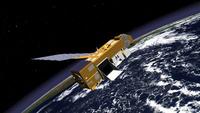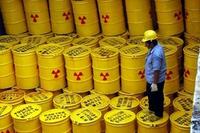-
Turning manure into clean water
Imagine something that can turn cow manure into clean water, extract nutrients from that water to serve as fertilizer, and help solve the ever-present agricultural problem of manure management. Technology is under development and near commercialization that can do all of that. While turning the manure into clean water makes environmental sense, the researchers are also looking into how this can make good financial sense for farmers. In some cases it could have a significant impact on the long-term viability of the farm.
-
-
Critics: U.K. nuclear watchdog plagued by “indefensible” conflicts of interest
Britain’s nuclear watchdog, the Office for Nuclear Regulation(ONR), is receiving technical advice from companies it is tasked with monitoring, leading industry insiders to accuse the watchdog of accepting advice tainted with “unbelievable” conflicts of interest. ONR’s chairman, Nick Baldwin, noted that the agency is concerned about possible conflicts of interest, but that there is a “small gene pool” of firms capable of advising ONR inspectors.
-
-
Guard fired for Y-12 breach says he was made a scapegoat for contractor’s failings
Kirk Garland, a security guard at the Y-12 National Security Complex in Oak Ridge, Tennessee, was fired from his job two weeks after three aging peace activists, led by an 82-year old nun, managed, on 28 July 2012, to breach the facility’s supposedly impregnable perimeter security systems, then loiter, unnoticed, on the grounds of the facility, where bomb grade uranium is stored. The activists had enough time to spray-paint peace messages and Bible verses on walls, slosh the walls with human blood, and wrap one of the buildings with crime-scene tape. In an arbitration hearing, Garland argued that he was made a scapegoat for the larger failings of the then-security contractor,Wackenhut Services.
-
-
Airports resist bolstering perimeter security because of cost
Last month’s security breach at Mineta San Jose Airport, in which a teenager entered the airfield and hid in the wheel well of a Maui-bound flight, has highlighted concerns about the security of airport perimeters. Perimeter intrusions are common at airports, but airports resist pressures to improve perimeter protection because of the costs involved. Experts note that if we were to string all of the U.S. airport perimeters together, we would approach the length of the U.S. border with Mexico and security expenditures approaching a billion dollars. These experts say that airports are not likely to invest heavily in perimeter security until a serious disaster due to lax perimeter security occurs. “Show me a body count, and we’ll build a fence,” said one airport administrator.
-
-
U.S., industry grappling with a growing nuclear waste problem
Thirty years ago congress voted to fund the building of centralized nuclear waste repository at the Yucca Mountain site in Nevada. Four years ago to Obama administration pulled to plug on the project, and nuclear wasted has continued to accumulate on the grounds of nuclear plants – active and shuttered – around the United States. As of May 2013, the U.S. nuclear industry had 69,720 tons of toxic nuclear waste to deal with. The administration strategy calls for a short-term centralized storage facility by 2025, and a permanent national geological repository by 2048.
-
-
Algae biofuel can help meet world energy demand
Microalgae-based biofuel not only has the potential to quench a sizable chunk of the world’s energy demands, researchers say. Microalgae produces much higher yields of fuel-producing biomass than other traditional fuel feedstocks and it does not compete with food crops. The researchers say that algae yields about 2,500 gallons of biofuel per acre per year. In contrast, soybeans yield approximately forty-eight gallons; corn about eighteen gallons.
-
-
Future cyberattacks to cause more trouble than Heartbleed
Many of the future cyberattacks could take advantage of vulnerabilities similar to Heartbleed, a major Internet security flaw which allows attackers to gain access to encrypted passwords, credit card details, and other data on trusted Web sites including Facebook, Gmail, Instagram, and Pinterest. A new report said that hackers could soon use similar holes in computer security to shut down energy grids, disrupt public services, and steal vast amounts of private data worth billions of dollars, unless institutions take measures today to ready themselves against future Heartbleed-like threats.
-
-
Port security technologies demonstrated in Gothenburg, Sweden
FOI, the Swedish Defense Research Agency, conducted a demonstration in Gothenburg of technology designed to improve the security of ports around the world. One of the reasons for the research into countering intrusion is that many ports find that they lack good and affordable tools for seaward surveillance, and so find it difficult to guard against terrorist attack and organized crime such as theft, smuggling, and stowaways. FOI has, therefore, created a system that is capable of detecting divers, swimmers, or small craft which might attempt to approach the quayside or a vessel tied up alongside.
-
-
Power plant emission detection by satellites verified

Air pollution and greenhouse gas emissions from two coal-fired power plants in the Four Corners area of northwest New Mexico, the largest point source of pollution in America, were measured remotely by a Los Alamos National Laboratory team. The study is the first to show that space-based techniques can successfully verify international regulations on fossil energy emissions.
-
-
Pressure grows for building a centralized nuclear waste repository
In 2010, after $9 billion and twenty-five years of construction, the Obama administration pulled the plug on the Yucca Mountain centralized nuclear waste repository. Toxic nuclear waste continues to accumulate on the grounds of U.S. nuclear power plants, with concerns growing about the security of keeping so may tons of such toxic materials in such a dispersed manner. Concerns have been heightened lately by the wave of closing, for economic reasons, of nuclear power plants, and worries about the safety of radioactive waste remaining behind on the grounds of shuttered plants. Senate Bill 1240 calls for the development of a Nuclear Waste Administrationto take responsibility for transporting and storing nuclear waste, and find the right geological location for a new centralized repository.
-
-
Cracked lid of a nuclear waste container may be source of WIPP radiation leak
The radiation leak at the Waste Isolation Pilot Plant (WIPP) near Carlsbad, New Mexico has been linked to a waste container shipped from Los Alamos National Laboratory (LANL), raising questions about the safety of other containers stored at the lab’s northern New Mexico facility and at the Waste Control Specialists (WCS) site in Andrews, Texas.As a precautionary measure, LANL has been ordered to remove thousands of similar containers filled with toxic waste from outdoor storage. Critics of nuclear waste storage practices have blamed the recent radiation accidents on a diminishing culture of safety at the fifteen-year-old WIPP.
-
-
Testing distributed computing to protect against cyberattacks on power grids
The power grid is complicated, divided up into sections that cover everything from a single municipal area (like New York City) to large regions (like the entire state of California). Each of these sections is controlled by a single control center. If that control center stops functioning, because of a cyberattack or for any other reason, it is no longer capable of monitoring and maintaining the grid, resulting in severe instabilities in the system. The SmartAmerica Challenge, which kicked off in late 2013 to highlight U.S. research in the field of cyberphysical systems, aims to address power grid security concerns.
-
-
Floating solar power plants offer many benefits
Water-based solar plants are at least 50 percent more efficient than a land-based solar power system.The water on which the plant floats helps extending the life of the photovoltaic panels, meaning greater efficiency and performance from the solar panel system, and the plant also prevents nearly 90 percent of the evaporation for the surface area that it covers, an important benefit in dry climates.
-
-
Safety of nuclear waste storage questioned

The aftermath of the Hiroshima and Nagasaki bombings, and the Chernobyl accident, offers proof that high doses of radiation can have pernicious effects on plant and animal life. The largest human-made radiation risk, however, lies in nuclear waste stored near reactors or in underground repositories like the Waste Isolation Pilot Plant(WIPP) in Carlsbad, New Mexico.
-
-
Researchers crack supposedly impregnable encryption algorithm in two hours
Without cryptography, no one would dare to type their credit card number on the Internet. Security systems developed to protect the communication privacy between the seller and the buyer are the prime targets for hackers of all kinds, hence making it necessary for encryption algorithms to be regularly strengthened. A protocol based on “discrete logarithms,” deemed as one of the candidates for the Internet’s future security systems, was decrypted by École polytechnique fédérale de Lausann (EPFL) researchers. Allegedly tamper-proof, it could only stand up to the school machines’ decryption attempts for two hours.
-
More headlines
The long view
Water Wars: A Historic Agreement Between Mexico and US Is Ramping Up Border Tension
As climate change drives rising temperatures and changes in rainfall, Mexico and the US are in the middle of a conflict over water, putting an additional strain on their relationship. Partly due to constant droughts, Mexico has struggled to maintain its water deliveries for much of the last 25 years, deliveries to which it is obligated by a 1944 water-sharing agreement between the two countries.
Trump Is Fast-Tracking New Coal Mines — Even When They Don’t Make Economic Sense
In Appalachian Tennessee, mines shut down and couldn’t pay their debts. Now a new one is opening under the guise of an “energy emergency.”
Smaller Nuclear Reactors Spark Renewed Interest in a Once-Shunned Energy Source
In the past two years, half the states have taken action to promote nuclear power, from creating nuclear task forces to integrating nuclear into long-term energy plans.
Keeping the Lights on with Nuclear Waste: Radiochemistry Transforms Nuclear Waste into Strategic Materials
How UNLV radiochemistry is pioneering the future of energy in the Southwest by salvaging strategic materials from nuclear dumps –and making it safe.
Model Predicts Long-Term Effects of Nuclear Waste on Underground Disposal Systems
The simulations matched results from an underground lab experiment in Switzerland, suggesting modeling could be used to validate the safety of nuclear disposal sites.
